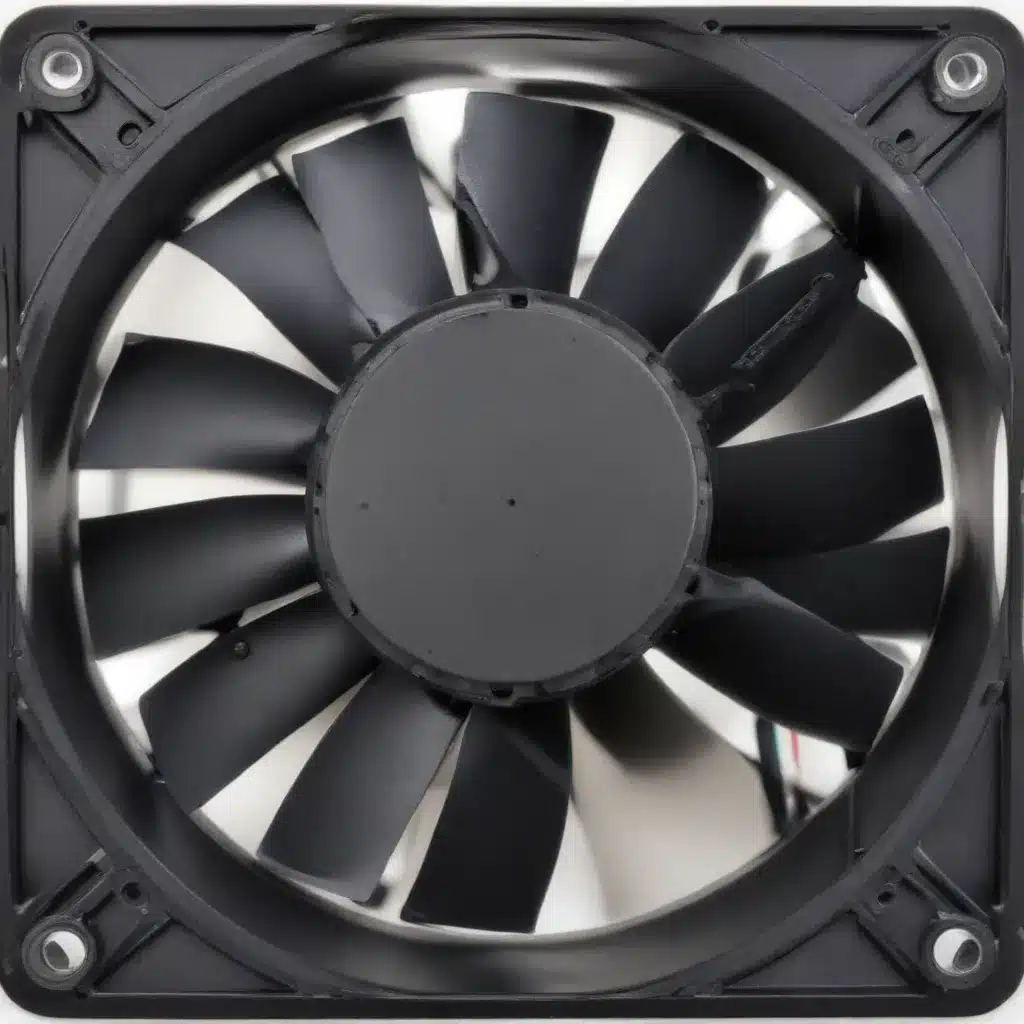
Mastering Air Flow: The Key to Optimal System Performance
As an experienced IT specialist, I’ve seen firsthand the crucial role that proper cooling plays in the smooth and efficient operation of computer systems. Whether you’re a tech-savvy enthusiast or a professional working in the IT industry, understanding the intricacies of computer fan types and airflow management can make all the difference in maintaining peak performance and extending the lifespan of your hardware.
In this comprehensive guide, I’ll share my personal insights and expertise on the various fan types available, the importance of airflow configuration, and the best practices for optimizing your system’s cooling solution. By the end of this article, you’ll be equipped with the knowledge to make informed decisions and take control of your PC’s thermal management.
Decoding the Fan Specifications
At the heart of any effective cooling system are the fans themselves. These unsung heroes of the PC world come in a variety of sizes, speeds, and performance specifications, each tailored to address specific cooling requirements. Let’s dive into the key factors to consider when selecting the right fans for your setup.
Fan Size: The most common fan sizes you’ll encounter are 120mm and 140mm, with some larger 200mm options available for certain cases. The larger the fan, the more air it can move at lower RPMs, resulting in reduced noise levels. When choosing your fans, be sure to check the compatibility with your case’s mounting points.
Cubic Feet per Minute (CFM): This metric represents the volume of air a fan can move, and it’s a crucial factor in determining the cooling capacity. Generally, you’ll want to aim for fans with a CFM of at least 50 for effective case cooling.
Rotations per Minute (RPM): This spec indicates how fast the fan blades are spinning, which directly correlates to the airflow rate. However, higher RPMs often come at the cost of increased noise levels, so it’s essential to find a balance between performance and acoustics.
Decibels (dB): This measurement reflects the fan’s noise output, and for a comfortable computing experience, you’ll want to look for fans with a rating below 30dB. Remember, the sweet spot is often a combination of high CFM and low dB.
Arranging the Airflow: The Science Behind Optimal Cooling
Now that you understand the key fan specifications, let’s delve into the art of configuring your case’s airflow for maximum efficiency. The goal is to create a seamless airflow channel that draws in cool air, guides it across heat-generating components, and then efficiently expels the warm air from the system.
The Front, Rear, and Bottom Configuration
One of the most effective cooling setups is the Front, Rear, and Bottom configuration. In this arrangement, fans at the front and bottom of the case draw in cool air, while the rear fan acts as the exhaust, creating a direct airflow channel across the core components.
This arrangement ensures that the GPU and CPU receive a constant supply of fresh, cool air, which is then efficiently expelled from the system. The addition of a bottom fan further enhances the air circulation, pushing the heated air upward and out through the rear exhaust.
The Front and Rear Configuration
Another common and reliable cooling setup is the Front and Rear configuration. In this arrangement, one or more fans at the front of the case draw in cool air, which is then guided across the motherboard and components and expelled through the rear exhaust fan.
While this configuration may not be as efficient as the Front, Rear, and Bottom setup, it still provides a solid airflow solution, particularly if your case’s front panel offers good ventilation to support the intake fans.
The Front, Rear, and Top Configuration
The Front, Rear, and Top configuration is another viable option, where fans at the front draw in cool air, and the rear and top fans work together to exhaust the heated air out of the system.
This arrangement can be effective, especially if your case’s top panel is well-ventilated. However, it may not be as efficient as the Front, Rear, and Bottom setup, as the upward airflow from the top fans may not reach the critical components as directly.
The Chimney Configuration
The Top and Bottom (Chimney) configuration is a less common but still viable cooling solution, particularly in cases where front and rear fan mounting is not an option. In this setup, fans at the bottom draw in cool air, which is then directed upward across the motherboard and expelled through the top exhaust fans.
This configuration is well-suited for vertically mounted GPUs, as it helps to ensure that the CPU and other components receive adequate cooling, even when the graphics card is obstructing the airflow.
Positive vs. Negative Pressure
When configuring your case fans, it’s also important to consider the concept of positive and negative pressure. Positive pressure is created when the fans pushing air into the case exceed the number of fans pulling air out, while negative pressure is the opposite, with more exhaust fans than intake fans.
Both positive and negative pressure configurations have their advantages. Positive pressure helps to keep dust out of the case and ensures a steady supply of cool air, while negative pressure quickly expels heated air. Many enthusiasts opt for a balanced approach, aiming for a neutral pressure setup to achieve the best of both worlds.
All-in-One Liquid Coolers: Optimizing Airflow
When dealing with all-in-one (AIO) liquid coolers, the fan configuration takes on a slightly different approach. These specialized cooling solutions often come with their own high-static pressure fans, which are designed to force air through the tight fin stacks of the radiator.
Push vs. Pull Configuration
The most common configuration for AIO liquid coolers is the Push orientation, where the fans push air through the radiator and out of the case. This arrangement is generally more effective, as it ensures that the heated air from the CPU is immediately expelled from the system.
Alternatively, you can opt for a Pull configuration, where the fans pull air through the radiator. While this setup is less common, it can still be effective, provided that the heated air is efficiently removed from the case.
Push-Pull Configuration
For those seeking the ultimate in cooling performance, the Push-Pull configuration is a popular choice. In this setup, the AIO’s included fans push air through the radiator, while an additional set of fans on the opposite side pull the air through, creating a powerful airflow.
This configuration does require additional space within the case, but the increased airflow can significantly boost the cooling capabilities of the AIO system.
Putting it All Together: Optimizing Your PC’s Cooling
Now that you’ve grasped the fundamentals of fan types and airflow configurations, it’s time to put this knowledge into practice and optimize the cooling of your PC. Here are some tips to help you get the most out of your system’s thermal management:
-
Assess Your Case and Components: Carefully examine your PC case and the layout of your internal components. Identify any potential airflow obstructions, such as cables or large heat-generating parts, and plan your fan placement accordingly.
-
Start with the Basics: If your case comes with pre-installed fans, use them as a starting point. Ensure that the rear exhaust fan is properly configured, and then consider adding intake fans at the front and/or bottom of the case.
-
Experiment with Fan Configurations: Don’t be afraid to experiment with different fan arrangements to find the optimal setup for your system. Try the Front, Rear, and Bottom configuration, or the Front and Rear setup, and monitor the temperatures and noise levels to determine the best arrangement.
-
Leverage AIO Liquid Coolers: If you’re using an all-in-one liquid cooler for your CPU, pay close attention to the fan configuration. Follow the manufacturer’s recommendations, and consider a Push-Pull setup for maximum cooling performance.
-
Customize Fan Speeds: Many motherboards and system utilities allow you to fine-tune the fan speeds based on component temperatures. Experiment with custom fan curves to find the sweet spot between cooling efficiency and noise levels.
-
Keep It Clean: Regularly clean your PC’s interior to ensure that dust and debris don’t impede airflow and compromise your cooling system’s effectiveness.
-
Monitor Temperatures: Use system monitoring software to keep a close eye on your PC’s temperatures, especially the CPU and GPU. This will help you identify any potential cooling issues and make necessary adjustments.
-
Invest in Quality Fans: While budget-friendly fans can be tempting, consider upgrading to higher-quality, high-performance fans. The improved airflow and reduced noise levels can make a significant difference in your system’s overall cooling efficiency.
Remember, effective cooling is not just about achieving the lowest temperatures; it’s also about maintaining a balance between performance and noise levels. By taking the time to understand and optimize your PC’s cooling solution, you’ll be rewarded with a system that runs smoothly, quietly, and reliably for years to come.
Conclusion: Mastering the Art of PC Cooling
In the ever-evolving world of computing, understanding and optimizing your PC’s cooling system is paramount. By applying the principles and best practices outlined in this comprehensive guide, you’ll be well on your way to unlocking the true potential of your hardware, ensuring peak performance, and safeguarding the longevity of your valuable investments.
Whether you’re a tech-savvy enthusiast or a professional IT specialist, mastering the art of PC cooling is a crucial skill that will serve you well. Embrace the challenge, experiment with different configurations, and trust your instincts – the rewards of a well-cooled, high-performing system are truly worth the effort.
If you’re interested in exploring more IT-related topics, be sure to check out https://itfix.org.uk/, where you’ll find a wealth of resources and insights from experienced professionals like myself. Together, let’s continue to push the boundaries of what’s possible in the world of computing and technology.












